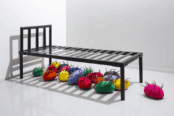It’s a hard thing to be confronted with the discarded detritus of one’s existence. The weight and detail of this truth hurts, or worse, condemns. For more than thirty years, Michael Landy has created boundary-pushing, monumental installations exploring questions of contemporary consumerism, value and waste. Challenging his audience as well as immersing them, his viewers are confronted, their fantasies realised and frustrations articulated. With a desire to engross audiences in the totality of his work, Landy has proven immutable in his resolve to force his audiences to see themselves truthfully.
“I’ve always liked things that are physically confrontational… I don’t like sculpture that’s too passive. So you’ve got to put stuff in front of people which might confront them.”

In Landy’s early installations, threads of value and waste question the tempestuous socio-economic legacy of Thatcherism. Market (1990) was made of constructed and deconstructed market stalls eerily devoid of produce. Installed in Building One, a former warehouse in East London transformed into an arts space, the location complemented the work in its observation of the transformation of the British economy, suggesting a dying way of life andthe death of the petit-bourgeois “nation of shopkeepers”. Market was followed in 1992 by Closing Down Sale, a take on the ongoing recession of the early 1990s.
“I’ve done Market, and I’ve done Closing Down Sale, where I took over my old gallery Karsten Schubert and turned it into a dayglo closing down sale, which was the title back in 1992. It was kind of like the end of the world in a way…
At that time Britain was going through a recession, so half of London felt like it was closing down. Some things critique the art market, but I’m not really that interested in the art market – more about the value we give to things. I think that’s what I talk about.”

That recession of the early 1990s is a touchstone of the YBA’s mythologising. This is usually discussed in relation to how it created the conditions for their success, such as Charles Saatchi’s interest in investing in young artists and the cheap availability of ex-industry spaces across east London. Landy, in contrast to his peers, confronted the economic reality through his early installations. Closing Down Sale saw the artist beginning his examination of waste, such as the sale of cheap disposable items and was his take on a theconsumerist culture of the time.
Scrapheap Services (1995) is the most overt and angry comment on the prevailing economic and political realities. Against the backdrop of high unemployment and poverty as a result of Thatcherite economics, Scrapheap Services is the manifestation of Landy’s fictional people-cleansing company, designed to dispose of those who are no longer valuable to society.
“Why put up with unsightly people who are such a burden on your resources, when you can turn to Scrapheap Services’ range of people control products?” – Landy 1995)

Promotional videos for the company ring out through the space, dystopian slogans advertise the disposal of people. The room is littered with thousands of tiny figures cut out from drinks cans to be trodden underfoot by participants on their journey through the space. Litter bins are filled with these figures as they are swept up to be eventually fed into the Vulture, a “specially designed people-chipper-shredder” (as described in the installation. adorned with the five evils highlighted in the 1942 Beveridge Report (1942)–: disease, idleness, ignorance, squalor and want – sit menacingly resolute, awaiting their absent functionaries. The construction of the space confronts viewers with their complicity in this new order.
“You’re complicit in a sense, we all witnessed it going on. I made all those little figures myself out of rubbish that I collected and….(read more in Trebuchet 15)
Read more in
Trebuchet 15: Installation
Featuring:
Installations as theatre
Giuseppe Penone
Michael Landy
Annette Messager
Karolina Halatek
Sounds Art as Installation
Jean Boghossian
Jon Kipps
Chantal Meza

Ruth O’Sullivan is a writer and curator. Her work explores the impact of digital technologies on contemporary art practices and challenging gender disparity within the visual arts.























